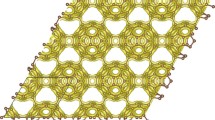Abstract
Ruff and Bretschneider1, in collaboration with Ebert, reported that the X-ray diffraction pattern of carbon monofluoride, (CF)n, had similar (hk.0) reflexions to graphite, but that the (000l) and other reflexions dependent on the c or carbon interlayer spacing were absent. From this they assumed that in carbon monofluoride the graphite structure is retained with expansion perpendicular to the carbon layers and, from a determined density of 2·39, calculated the carbon interlayer spacing to be 8·17 A. They postulated that the fluorine atoms acquire electrons from the carbon rings and that the ions so produced lie in a closely packed structure in six parallel layers between each pair of carbon planes requiring a theoretical carbon interplanar spacing of 8·05 A. Although such a structure could reasonably account for the low electrical conductivity and explosive decomposition of the compound, it is very doubtful, as pointed out by Bigelow2, whether such an arrangement would have even limited stability. Bigelow proposed an alternative structure in which the fluorine atoms lie in two parallel planes about each plane of carbon atoms, to which they are linked by polarized covalent bonds. Assuming a normal C—F bond of about 1·4 A., the excessively high spacing of 5·3 A. between the planes of fluorine atoms was explained by electrostatic repulsion resulting from the polarization.
This is a preview of subscription content, access via your institution
Access options
Subscribe to this journal
Receive 51 print issues and online access
$199.00 per year
only $3.90 per issue
Buy this article
- Purchase on Springer Link
- Instant access to full article PDF
Prices may be subject to local taxes which are calculated during checkout
Similar content being viewed by others
References
Z. anorg. Allgem. Chem., 217, 1 (1934).
Chem. Rev., 40, 83 (1947).
Briscoe and Warren, J. App. Phys., 13, 364 (1942).
Warren, Phys. Rev., 59, 693 (1941).
Wiener Chem. Z., 47, 191 (1944).
Author information
Authors and Affiliations
Rights and permissions
About this article
Cite this article
PALIN, D., WADSWORTH, K. Structure of Carbon Monofluoride. Nature 162, 925–926 (1948). https://doi.org/10.1038/162925c0
Issue Date:
DOI: https://doi.org/10.1038/162925c0
This article is cited by
-
Tailoring the chemical composition and dispersion behavior of fluorinated graphene oxide via CF4 plasma
Journal of Nanoparticle Research (2015)
Comments
By submitting a comment you agree to abide by our Terms and Community Guidelines. If you find something abusive or that does not comply with our terms or guidelines please flag it as inappropriate.



